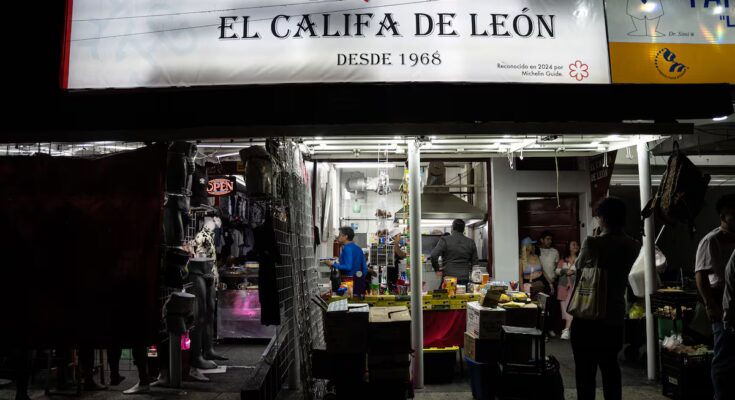Two hours before opening in the American city of University Park, Dallas, El Califa de León, the famous Mexican taqueria awarded with a Michelin star, already had a line stretching for more than two blocks. The anticipation generated by the Mexico City facility, recipient of one of the highest awards in world gastronomy, was sky-high. The opening was part of a temporary collaboration with a company called GrinGO, which would operate from October 17-25. What should have been a strategic, unique and exclusive dining experience, bringing the “flavor and quality” of a traditional, “house brand” gaonera taco, became a disastrous experience where diners had to wait hours for service that, in some cases, they were unable to receive. Mario Hernández, owner of the company founded in 1968, had to make the decision to close his doors just 48 hours after opening and to leave before his company’s name was damaged. The Michelin star has opened an international showcase for him, but has also given him the burden of responsibility to meet expectations and respect quality standards.
“For us it is a great joy and a great responsibility,” Hernández told local media present at the inauguration. However, between the second and third days, the complaints began to increase. There were people who waited five to seven hours only to end up not receiving the food they had waited for. Others made reservations through the app for a time, only to receive an order of three tacos two hours later. There were also those who complained about the price of the food. The taco de gaonera, a beef fillet; pork chop or ribeye, all grilled with just salt and a squeeze of lemon, sold for $10, $9, and $12, respectively. Almost double or triple, depending on the meat chosen, the value at which it is sold in the capital.
The factors that contributed to the first fiasco of the Caliph of León outside Mexico were several. One of the main ones was a gas leak which caused the service to be postponed on the second day. There was no adequate communication regarding this inconvenience, so many people did not find out about it and showed up for their appointment at the restaurant only to find it closed. Once the fault was resolved, it was reopened on the third day, but the number of people left pending from the previous day continued to increase and forced the kitchen to stop for several hours to replenish the ingredients and prepare them.
“We paid $340 for a reservation for four people. It included an appetizer, Michelin four-star tacos, a dessert and drinks. We received two tacos. The gaonera one was very dry and I liked the short rib one, but they arrived cold. You could tell they were understaffed and should have prepared better,” says Amanda J., a diner who frequented the restaurant.
The culinary venture in Texas was organized by GrinGO, a travel and safety app for American and Canadian tourists in Mexico. Hernández says he has no qualms about the professionalism of the person in charge pop-up shop (a temporary store) that brought the Caliph of León to Dallas. He admits that he has been well promoted on social networks, radio and television. However, he admits that his partner, whose name he did not want to reveal, failed in his foresight in the operational part. EL PAÍS contacted GrinGO, but did not receive a response until the publication of this text.
“There was no adequate preparation and no consideration was given to the extraordinary response of the customers. My wife appreciated it and said to me: ‘Hey, people are cruel with the name of the Caliph’. She echoed what she told me and I said to her: ‘OK, you are absolutely right in the world. We must not play this way with the name and the best thing is to cancel, with all the shame in the world, because we did not have the necessary tools to move forward,’ Hernández says via telephone.
In Mexico City, El Califa de León has become an international point of interest on Avenida Ribera de San Cosme, a famous spot in the capital, in the San Rafael neighborhood, for the semi-permanent tianguis (market) that occupies much of the south side of the street. The first thing that strikes you upon entering their small restaurant, which has remained in the same location for almost 70 years, are the two Michelin Guide signs that highlight the award received in 2024 and which confirms it this year as the only taco kiosk in the world with the coveted star. The lines aren’t as long as last year, but the crowd is still packed every Thursday at lunchtime. The cuts of meat are on display, while he offers and explains them, in English and Spanish, to local customers and those arriving from outside.
In front of the grill where the cuts are cooked, seasoned with coarse salt and a squeeze of lemon, where the tortillas are also prepared to order, a Japanese man, a Puerto Rican couple and an American wait for their order to come out. The consensus from all three is that the tacos live up to the hype.
Andrew Teddy Torres, an expert taster of Garnachas, Mexican snacks, and content creator, believes that one of the positive aspects of a recognition like the one assigned by the Michelin Guide is the value that is added to the work of all the people behind this business and the street food sector. “Most Mexicans appreciate this type of food, but what this type of recognition allows is for other cultures and other social strata to recognize it and venture out to try it. Furthermore, I think it is important that people from outside or from other neighborhoods also see what is beyond certain traditional areas where the food is usually recognized,” he explains over the phone.
Celebrities are also regulars here. Paco Ayala, bassist and one of the voices of the rock group Molotov, believes that the Michelin recognition is deserved. He says he is a regular customer and that the aspects he likes most are the quality of the meat and that the sauces, the traditional fresh green one and the red one they offer, “are still spicy”. It does not believe that the recognition has caused a deterioration in the quality or treatment of customers.
Mercedes Hinojosa, sociologist and academic at UNAM, emphasizes that, ultimately, cooking is dynamic and social. It’s a matter of taste, he explains, having to do with one’s vision, experiences, biology, taste buds, personal taste or a memory. He agrees with Torres that the Michelin Guide continues to achieve its goal of attracting “bourgeois consumption” and encouraging travel, but warns that it is important to see that the award does not just validate a certain type of food.
“The cuisine in Mexico is very varied and is also very dynamic. It has always reinvented itself. A negative aspect would be to establish a parameter so that all the food is aestheticized and standardized. It is important to always recognize and claim the culinary diversity of the country, that the pozole that you eat in the city center is not the same as what you eat further north. The Michelin star has a positive side, but for me the negative side would be to establish the stars as a parameter of how the food should be, as a homogenization of what let’s eat,” adds Hernández on the phone.
Hernández is aware of the pressure on him. His family’s goal is to keep the star for as long as possible. But despite this latest setback, he is ambitious: “To be able to gain one more star, not just keep it. This is my goal, for the people who collaborate with me. This is the challenge we have at the moment. It’s a great responsibility we have.”



